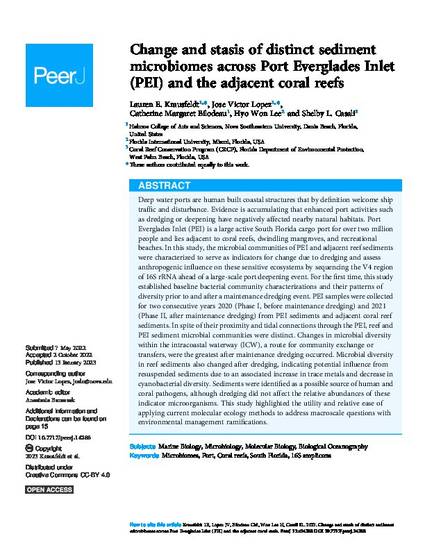
- Microbiomes,
- Port,
- Coral reefs,
- South Florida,
- 16S amplicons
Deep water ports are human built coastal structures that by definition welcome ship traffic and disturbance. Evidence is accumulating that enhanced port activities such as dredging or deepening have negatively affected nearby natural habitats. Port Everglades Inlet (PEI) is a large active South Florida cargo port for over two million people and lies adjacent to coral reefs, dwindling mangroves, and recreational beaches. In this study, the microbial communities of PEI and adjacent reef sediments were characterized to serve as indicators for change due to dredging and assess anthropogenic influence on these sensitive ecosystems by sequencing the V4 region of 16S rRNA ahead of a large-scale port deepening event. For the first time, this study established baseline bacterial community characterizations and their patterns of diversity prior to and after a maintenance dredging event. PEI samples were collected for two consecutive years 2020 (Phase I, before maintenance dredging) and 2021 (Phase II, after maintenance dredging) from PEI sediments and adjacent coral reef sediments. In spite of their proximity and tidal connections through the PEI, reef and PEI sediment microbial communities were distinct. Changes in microbial diversity within the intracoastal waterway (ICW), a route for community exchange or transfers, were the greatest after maintenance dredging occurred. Microbial diversity in reef sediments also changed after dredging, indicating potential influence from resuspended sediments due to an associated increase in trace metals and decrease in cyanobacterial diversity. Sediments were identified as a possible source of human and coral pathogens, although dredging did not affect the relative abundances of these indicator microorganisms. This study highlighted the utility and relative ease of applying current molecular ecology methods to address macroscale questions with environmental management ramifications.
Available at: http://works.bepress.com/jose-lopez/284/

Data Availability
The following information was supplied regarding data availability:
The sequences are available at the National Center of Biotechnology Information (NCBI) Sequence Read Archive (SRA): PRJNA742832.
Supplemental Information
Supplemental information for this article can be found online at http://dx.doi.org/10.7717/ peerj.14288#supplemental-information.